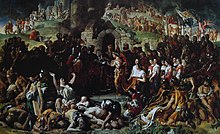Aoife MacMurrough
Aoife MacMurrough | |
|---|---|
 The Marriage of Strongbow and Eva (1854) by Daniel Maclise, a romanticised depiction of the union between Aoife and Richard de Clare in the ruins of Waterford | |
| Born | 1145 |
| Died | 1188 |
| Noble family | Uí Chennselaig (MacMurrough-Kavanagh family) |
| Spouse(s) | Richard de Clare, 2nd Earl of Pembroke |
| Issue |
|
| Father | Dermot MacMurrough |
| Mother | Mor O'Toole |
Aoife MacMurrough (c. 1145 – 1188, Irish: Aoife Nic Mhurchada), also known as Eva of Leinster, was an Irish noblewoman, Princess of Leinster and Countess of Pembroke. She was the daughter of Dermot MacMurrough (c. 1110 – 1171) (Irish: Diarmait Mac Murchada), King of Leinster, and his second wife, Mór Ní Tuathail or Mor O'Toole (c. 1114 – 1191), and a niece of Archbishop of Dublin St Lawrence O'Toole.
Life[edit]
As the daughter of the Gaelic nobility of Ireland, the young Aoife would have been raised in much higher dignity than most other girls in Ireland who were of poorer stock than she; her privileged status ensured that she was educated in Brehon law and would have ensured that she was literate in Ecclesiastical Latin. Since her mother (who also produced one son and another daughter) was the second wife of Diarmait, her station was automatically lower than that of her husband's first wife, Sadb Ní Faeláin, and her issue of two sons and one daughter.
On 25 August 1170, following the Norman invasion of Ireland that her father had requested, she was married to Richard de Clare, 2nd Earl of Pembroke, better known as Strongbow, the leader of the Norman invasion force, in Christchurch Cathedral in Waterford. Her father, Dermot MacMurrough, who was seeking a military alliance with Strongbow in his feud with the King of Breffni, Tiernan O'Rourke and the High King of Ireland, had negotiated a dynastic marriage between Aoife and Strongbow. However, according to Brehon law, both the man and the woman had to consent to a marriage, so it is fair to conclude that Aoife agreed to an arranged marriage.[1]
Under Anglo-Norman law, this gave Strongbow succession rights to the Kingdom of Leinster. Under Brehon law, the marriage gave her a life interest only, after which any land would normally revert to male members of the derbhfine; but Brehon law also recognised a transfer of "swordland" following a military conquest. Aoife repeatedly led troops into battle and is sometimes known as Red Eva (Irish: Aoife Rua).[2]
She had two sons and a daughter with her husband Richard de Clare and through their daughter, Isabel de Clare, within a few generations their descendants included much of the nobility of Europe including all the Kings of Scotland since Robert the Bruce (1274–1329) and all those of England, Great Britain and the United Kingdom since Henry IV (1367–1413); and, apart from Anne of Cleves, all the queen consorts of, as well as, Henry VIII.[3]
Death[edit]
While the exact date of the death of Aoife of Leinster is unknown (one suggested year is 1188), there is in existence one tale of her demise.[citation needed] As a young woman, she lived many years following the death of Strongbow in 1176, and devoted herself to raising their children and defending their territory.[citation needed]
Issue[edit]
| Name | Birth | Death | Notes |
|---|---|---|---|
| Isabel de Clare, 4th Countess of Pembroke | 1172 | 1220 | m. Aug 1189, Sir William Marshal, 1st Earl of Pembroke, Lord Marshal, son of John Fitz Gilbert, Marshal (Marechal) of England, and Sibylla of Salisbury. |
| Gilbert de Striguil (Chepstow), 3rd Earl of Pembroke | 1173 | 1185 | Inherited title from father but died as a minor. The title then went to his sister's husband on their marriage. Isabel's husband, William Marshal, was given the title Earl of Pembroke in his own right by King John of England. Marshal did not call himself the Earl until he had achieved the privilege in his own right in 1199, rather than through his marriage to Isabel. |
See also[edit]
References[edit]
- ^ Hull, Eleanor (1931). A History of Ireland and Her People. Retrieved 12 August 2016.
- ^ Brian Igoe (2012). The Story of Ireland. Smashwords. p. 35. ISBN 978-1-301-36210-3.
- ^ Lundy, Darryl. "Robert I Bruce, King of Scotland". The Peerage. Retrieved 12 August 2016.
Sources[edit]
- O Croinin, Daibhi (1995) Early Medieval Ireland 400–1200 London: Longman Press; p. 281
- Salmonson, Jessica Amanda (1991) The Encyclopedia of Amazons. Paragon House. Page 160. ISBN 1-55778-420-5
- Weis, Frederick Lewis Ancestral Roots of Certain American Colonists Who Came to America Before 1700, Lines: 66–26, 175–7, 261–30
- 1140s births
- 1188 deaths
- 12th-century Irish people
- People from County Wexford
- Medieval Gaels from Ireland
- 12th-century Irish women
- MacMorrough Kavanagh dynasty
- Women in 12th-century warfare
- Irish expatriates in England
- Women in medieval European warfare
- Irish princesses
- Gaels
- Women in war in Ireland
- English countesses
